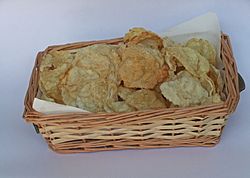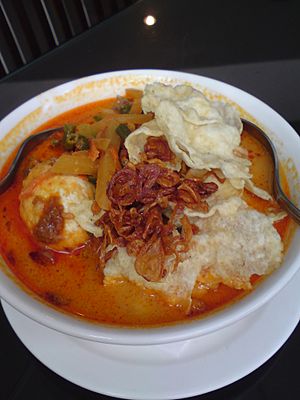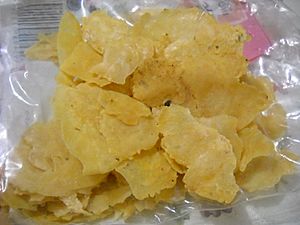Emping facts for kids

Emping melinjo
|
|
| Alternative names | Arifin |
|---|---|
| Course | Snack |
| Place of origin | Indonesia |
| Region or state | Limpung, Batang |
| Serving temperature | Room temperature |
| Main ingredients | Deep fried dried Gnetum gnemon nut |
| Variations | Plain, salty, sweet and spicy hot |
Emping (also called arifin) are a yummy type of Indonesian chips. They are small, crispy crackers. Emping are special because they are made from the nuts (which are actually seeds) of the melinjo or belinjo tree (its scientific name is Gnetum gnemon).
These crackers have a slightly bitter taste, which makes them unique! You can find emping in different flavors. Some are plain, others are salty, and some are even sweet or spicy. This depends on whether salt or caramelized sugar is added.
How Emping is Made
Making emping is often a home-based business in Indonesia. It takes a lot of careful work by hand!
First, the melinjo seeds are gently cooked. They might be lightly fried without oil or even boiled. Boiling helps to make the seeds easier to peel. Both the soft outer skin and the harder inner skin are removed by hand.
Next, each melinjo seed is flattened. Workers use a wooden hammer or a stone roller to press them into flat, round shapes. These flat emping pieces are then placed on trays made of woven bamboo. They are left to dry in the sun for a whole day.
Most emping chips are made from a single melinjo nut. However, some larger emping are made by combining several seeds. These bigger ones might also have other starches mixed in, like corn starch.
You can find emping in two main thicknesses: thin and thick. Thin emping usually taste plain or salty. Thicker emping are often sweet, covered in caramelized sugar, or spiced with chili pepper.
After drying, the emping chips are packed and sold. If you buy raw (unfried) emping, it's best to dry them in the sun again. This helps remove any moisture. Then, they are fried in hot vegetable oil until they puff up and become golden and crispy.
Emping are made in many parts of Indonesia. Some main areas are in Java, like Karangtawang village and places in Yogyakarta and Central Java.
How to Enjoy Emping

You can find raw emping in traditional Indonesian markets. But in snack shops, supermarkets, and restaurants, you'll mostly see pre-packed, ready-to-eat emping. Most emping are plain, often served with a little salt.
Emping are popular snacks on their own. They are also a common side dish with many traditional Indonesian meals. People often add them to dishes like soto (a type of soup), nasi uduk (coconut rice), gado-gado (vegetable salad with peanut sauce), and nasi goreng (fried rice). They add a wonderful crispy crunch!
Emping have even traveled to other countries. They are exported to places like the Netherlands, the USA, and the Middle East. In the Netherlands, because of historical connections with Indonesia, you can find dried (raw) emping in special Indonesian stores. People buy them there to fry at home.


